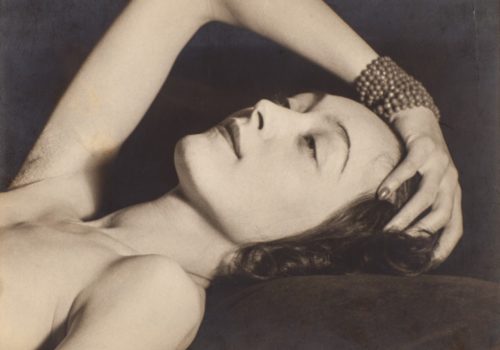In London, Tate Modern is showcasing the pop star’s photographic treasure trove and, in 200 works and 60 masters, tells the story of a passion.
Like a little boy who’s bored at school, his round face framed in a classic feathered fringe, he stares with his right eye into the unknown as he waits for the shutter to click. His left eye, however, is blurry like the eye of a dreamer having a nightmare. Half of his face, captured in 1997 by the inspired lens of the great Irving Penn, appears distorted. Here is a portrait like none you’ve ever seen before of sir Elton Hercules John, born Reginald Kenneth Dwight on March 25, 1947 in Pinner in Greater London, a pop and rock star of unprecedented success, who performed a record number of 5,000 plus shows in more than a hundred countries. It takes a good sense of humor—and a special dose of narcissism—to be able to accept such a quirky portrait and hang it in a museum among 200 modernist masterpieces from his photography collection. With the same fondness for badinage and litotes, Tate Modern titled this original display of beauty “The Radical Eye.”
A film featured in the exhibition gives voice and image to this singular collector who has been shaking up the art market for over twenty years. In his apartment covered floor to ceiling with photographs—hung, tacked, and crammed like posters in a teenager’s bedroom—amid leopard prints and sundry objects not always of museum value, Elton John talks as a professional celebrity. Cash. “I became interested in photography when I quit drinking,” he candidly explains in the scholarly catalog put together by Tate Modern. “After rehab in 1990, I went to France to spend time with some friends who own a chateau in Cahors. They had helped organize a photography festival. Photos were on display everywhere you turned, even outdoors. I had never really noticed photography as an art form before, even though I had had my picture taken by some wonderful photographers over the years, from Norman Parkinson to Terry O’Neill to David Bailey,” he tells Jane Jackson, his photography advisor and then curator of The Sir Elton John Photography Collection from 2003 to 2012.
“A healthy addiction”
The guests at the chateau included the Los Angeles gallery owner, David Fahey, who brought over some gems by Horst P. Horst, Irving Penn, and Herb Ritts, three masters of the black-and-white sublime who transform fashion into a pure simplicity of studied forms. The California photographer Herb Ritts came in person. Photography collecting was still in its infancy, limited to a small circle of aficionados. “I bought twelve on the spot. I suddenly became intensely interested in photography.” “It’s funny, but after rehab, I wasn’t interested in anything that I’d collected before. I love objects. I’ve always loved objects. As a child, my parents argued a lot, so I found comfort in objects and my collections of records, toys were all beautifully kept. When I started making money, I got interested in Art Deco and Art Nouveau. I read all I could on the subject, and became quite savvy. Before I went into rehab, I sold it all in a big one-week auction at Sotheby’s,” summed up matter-of-factly Elton John.
An emotional charge
His first purchases at age 43 were Elliott Erwitt, Harry Callahan, and Ray Metzker. Fashion, flowers, and portraits were a solid entry point for the beginner who, as a true photo enthusiast, soon turned to the experimental works of the 1920s, 1930s, and 1940s. The latter constitute the core of the Tate Modern exhibition. “As I learned more about photography, I saw that these artists were able to do things I had thought only a painter could do,” unpretentiously commented the virtuoso pianist, son of a Royal Air Force squadron commander and an amateur jazz trumpet player. Elton John confesses to having been “blown away” by the Underwater Swimmer, 1917. A total stroke of genius by a young André Kertész (1894–1985), the photograph was taken in the artist’s native Hungary and has since become treasured by museums for its abstract, avant-garde quality. The musician-collector first obtained a later print of this photo, dating from the 1970s. He had to wait years before coming across a vintage print that would spark his imagination. One day, the New York gallery owner Peter MacGill called him with an offer of a print from a contact sheet, the very first in the royal series. Here is the minuscule photo (4.1×5.7 cm), framed in crayon by the artist, which presides over the exhibition like a pharaoh on his throne, possessed of an extraordinary emotional charge.
“When I was a kid,” the musician confided to Jane Jackson, “I used to buy Man Ray posters. I bought a poster of his Lips, the only thing I could afford. Many people can’t afford the originals, and it’s wonderful that art is made accessible otherwise.”
The exhibition adopts a novel formula: well informed and popular. The Radical Eye brings together 25 vintage prints by Man Ray (1890–1976). The fabulous portraits by this New York Dadaist turned Paris Surrealist, include André Breton, Constantin Brancusi, Henri Matiss, Berenice Abbott, and the beautiful Dora Maar, solarized like a goddess.
Valérie Duponchelle
Valérie Duponchelle is an art critic at Le Figaro. This article appeared in the January 12, 2017 edition of the newspaper.
The Radical Eye, Modernist Photography from the Sir Elton John Collection
November 10, 2016 – May 7, 2017
Tate Modern
Bankside
London SE1 9TG
UK
















